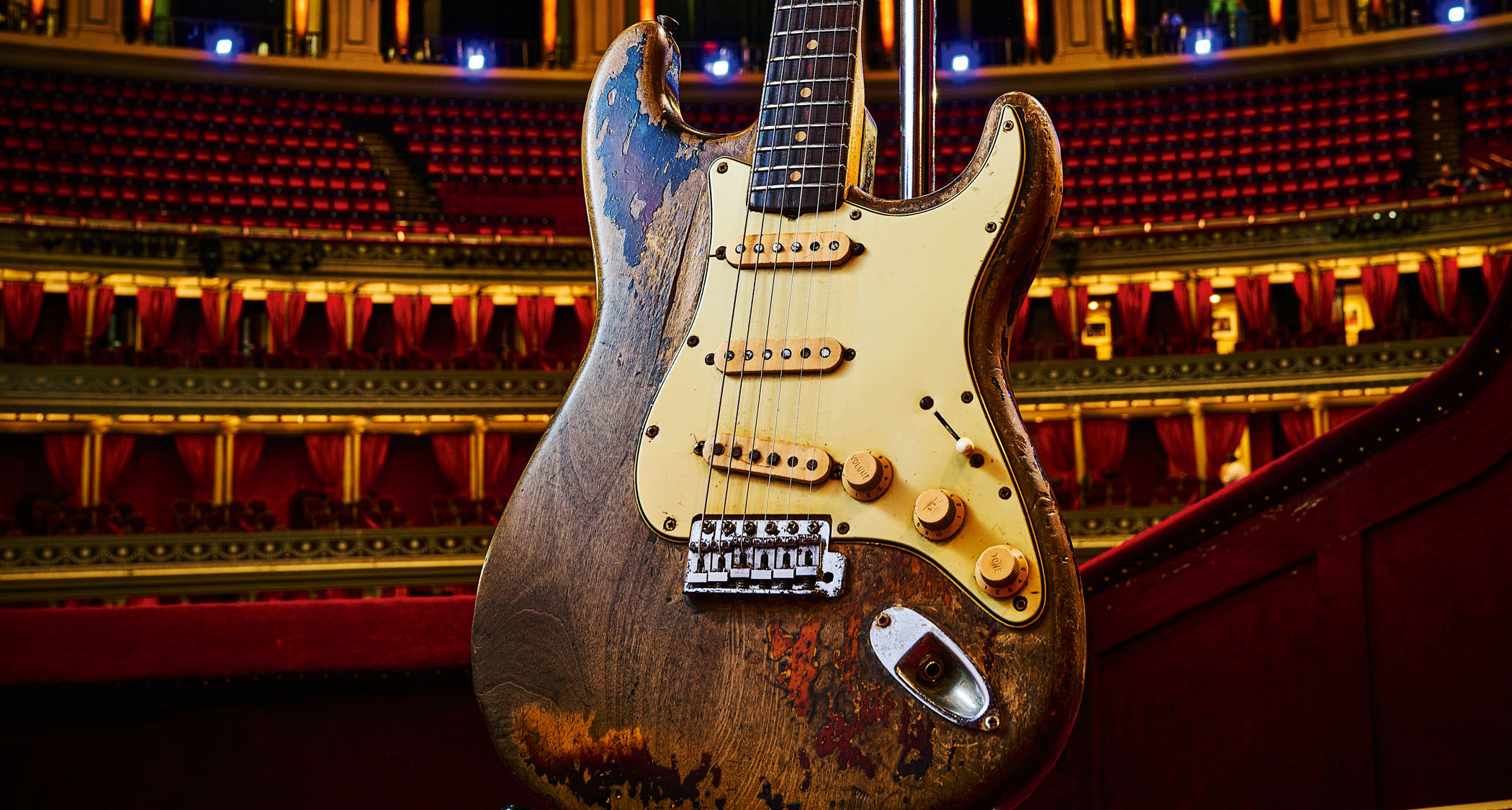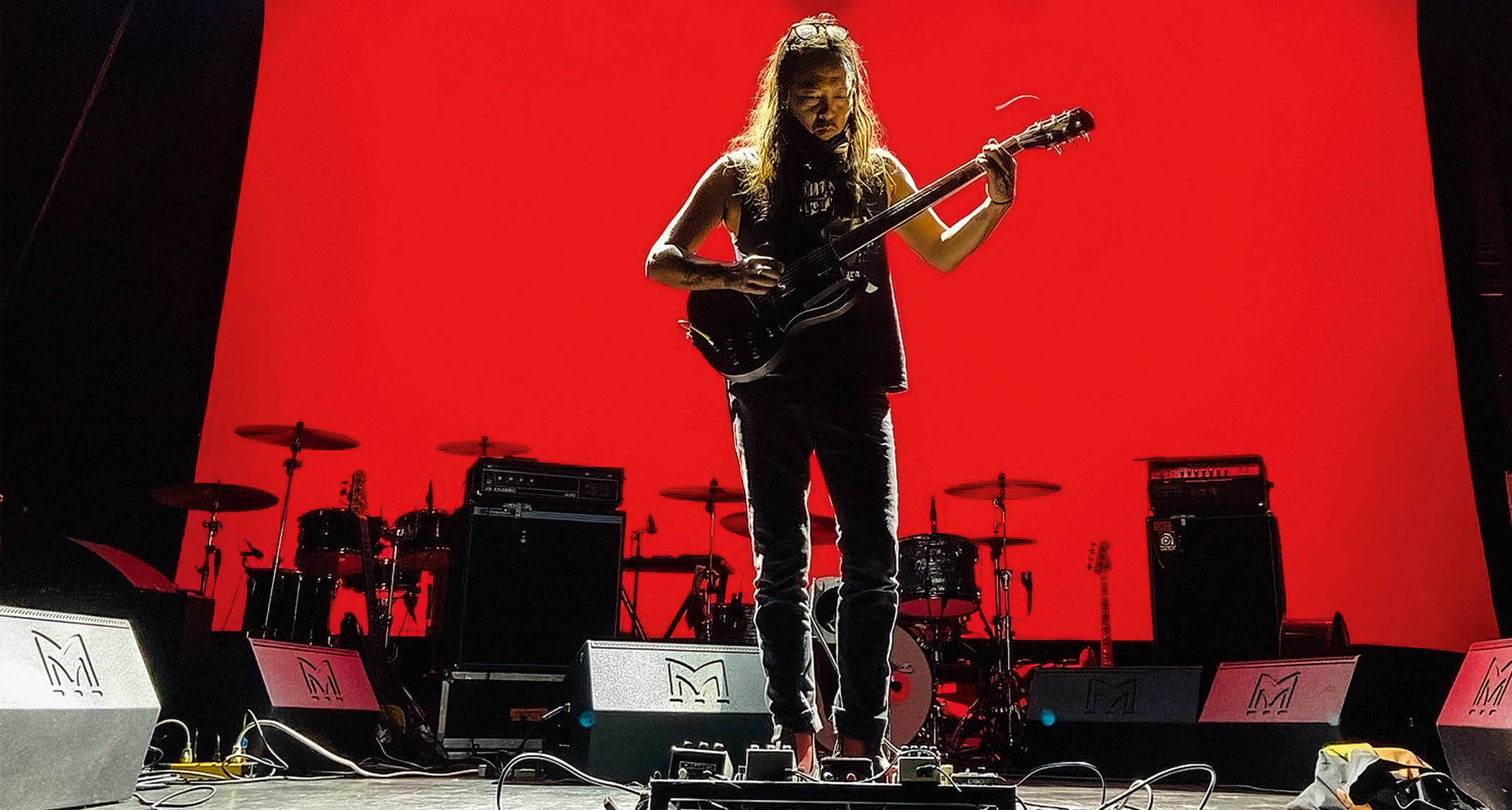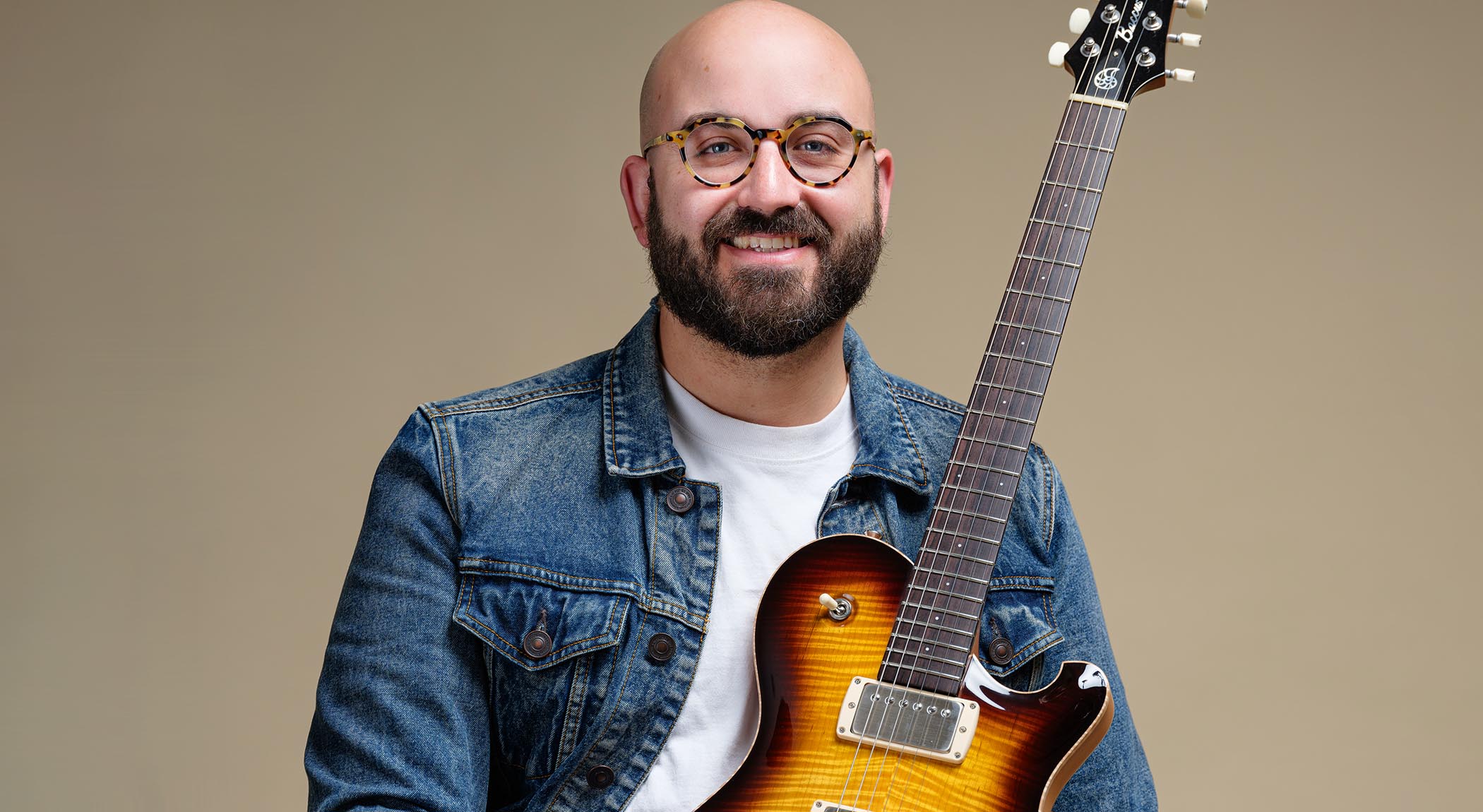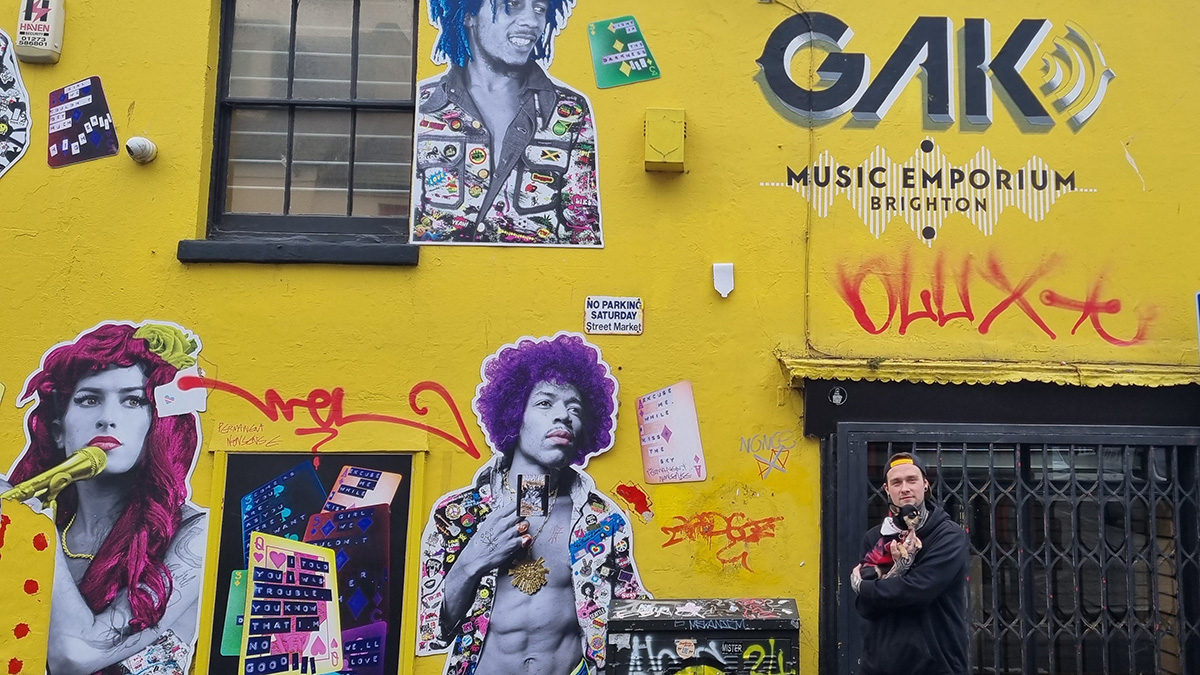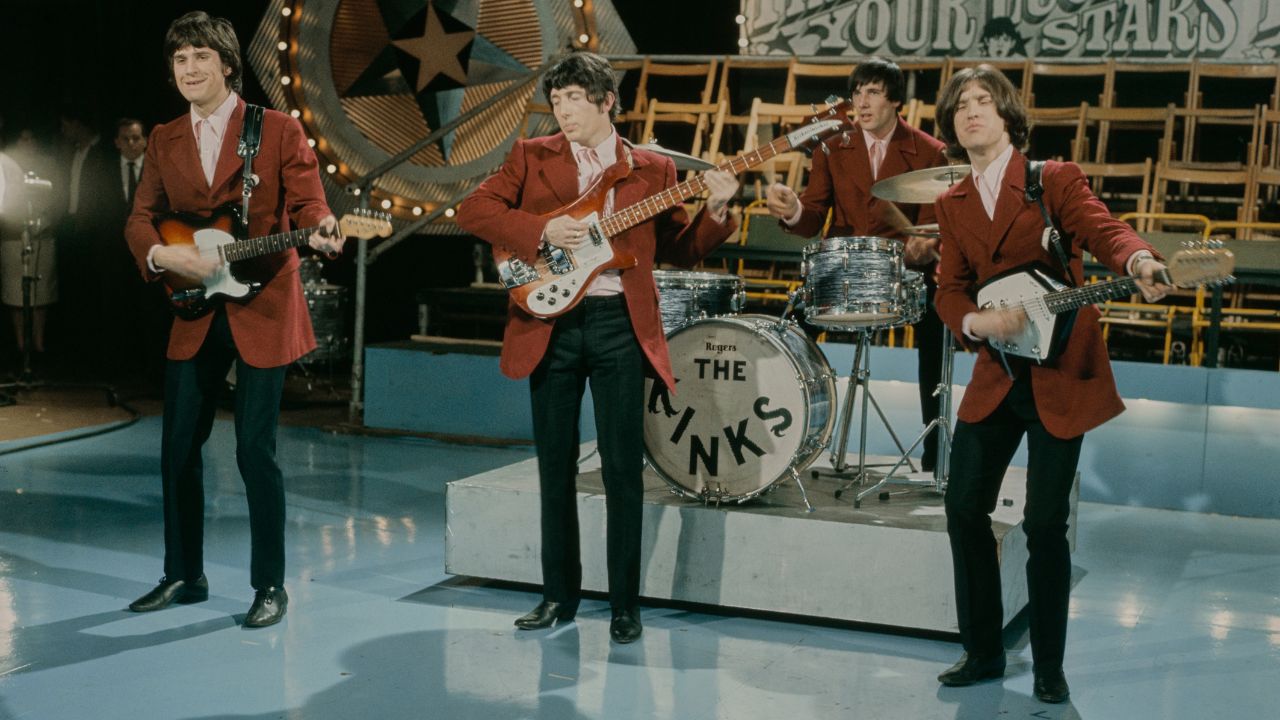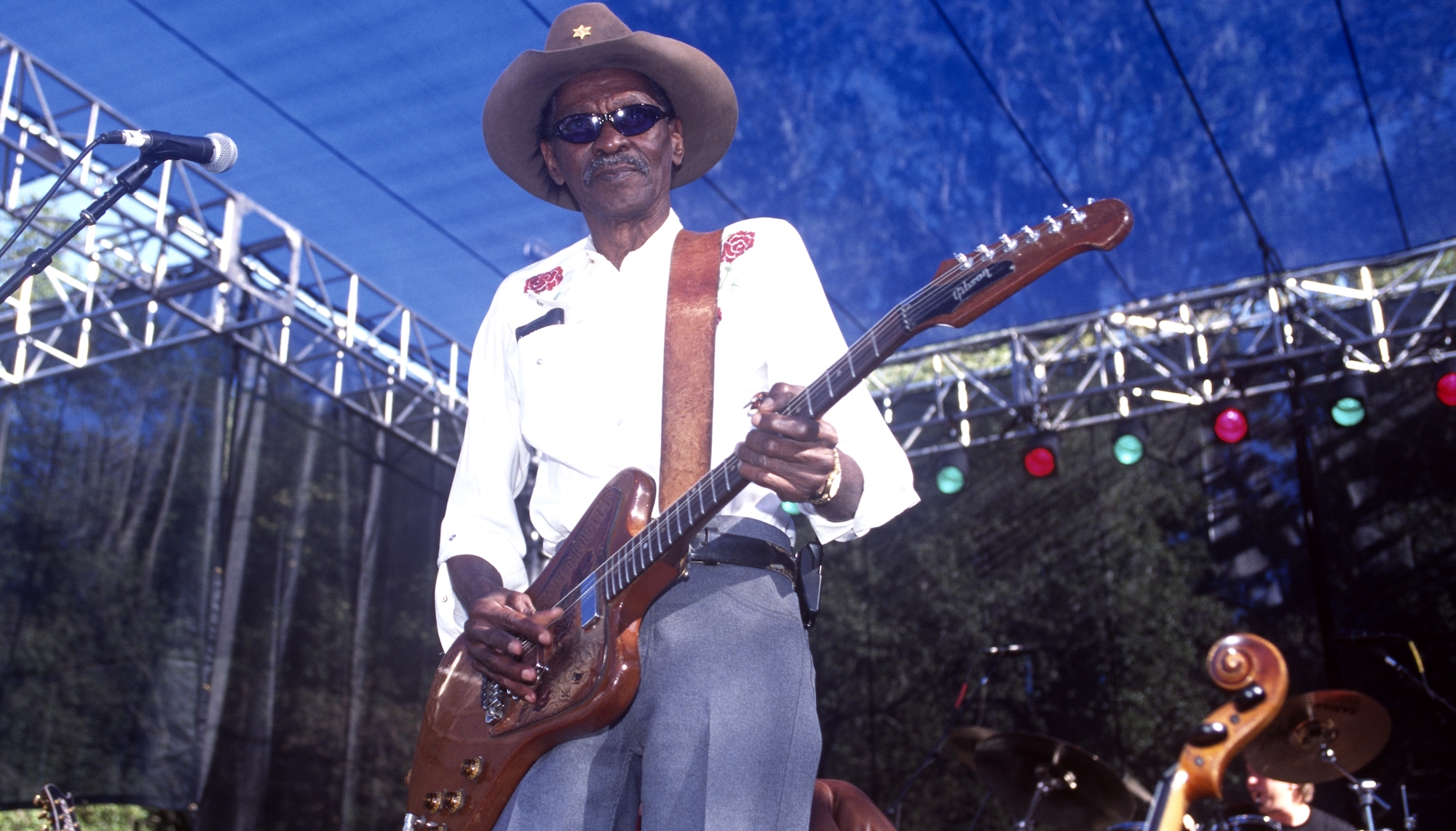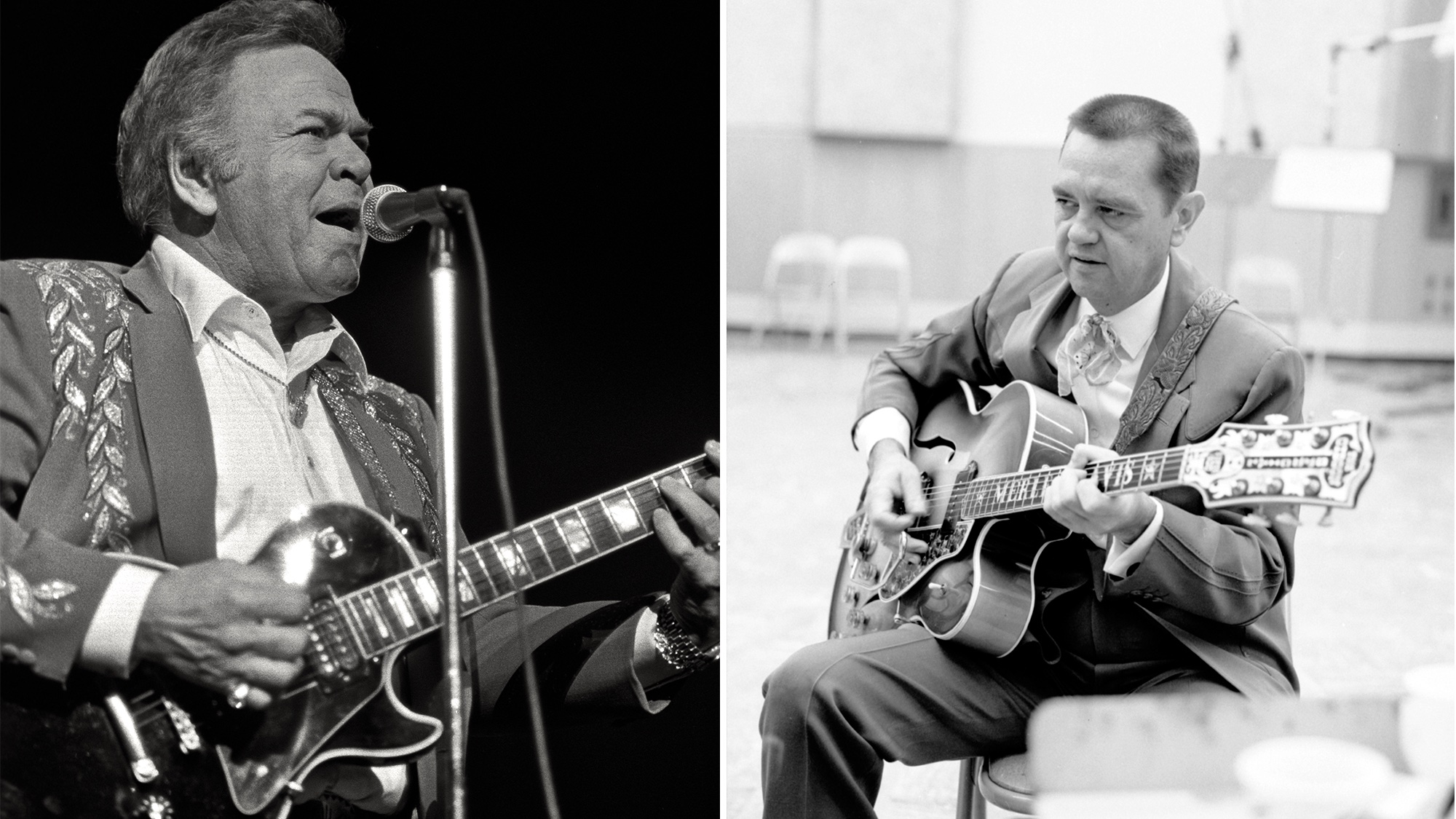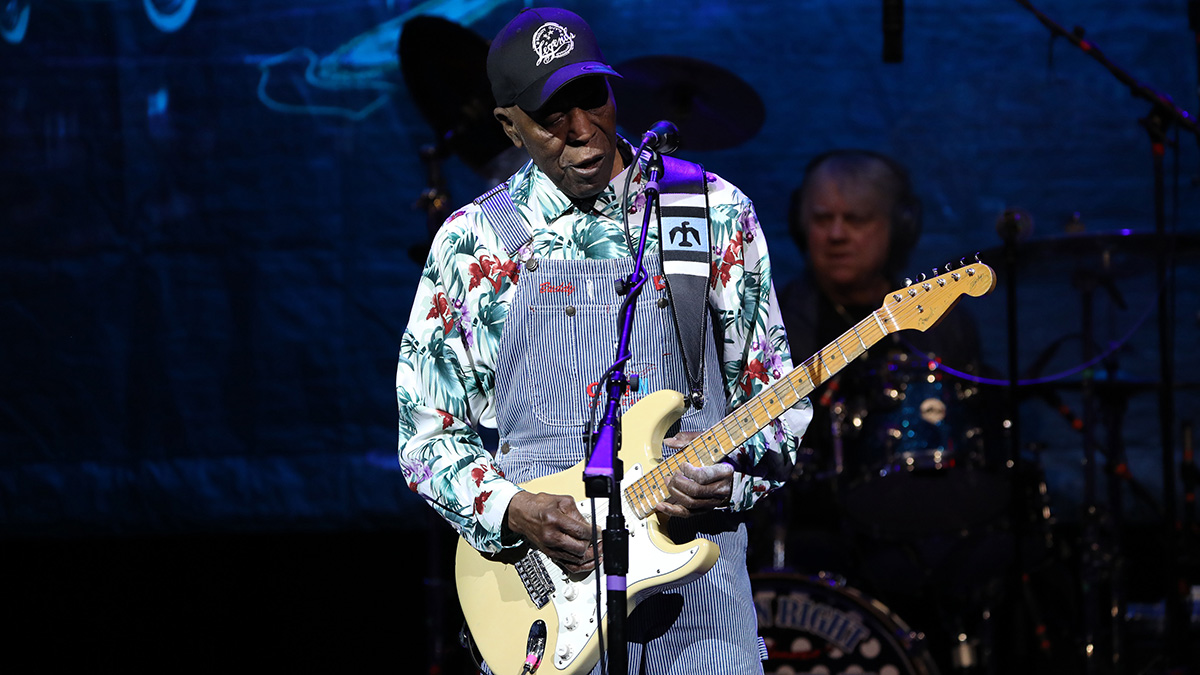Carlos Santana: Whole Lotta Lover
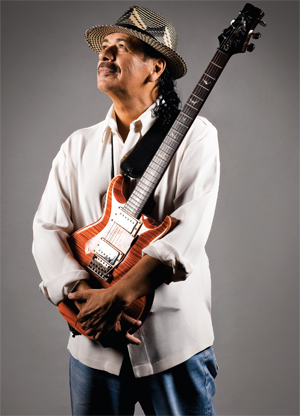
Originally published in Guitar World, November 2010
Carlos Santana gets his muse in the mood with a new girlfriend and a new album, Guitar Heaven, on which he and a star-studded cast cover classic rock tracks.
I’m in love,” Carlos Santana announces. It’s a somewhat surprising declaration coming from a 63-year-old man. Yet here he is, Carlos Santana, gushing like a lovestruck teenager. The new lady in his life is drummer Cindy Blackman, a jazz/rock veteran who has played with Lenny Kravitz and Pharaoh Sanders, among others. A true romantic, Carlos proposed to his new love onstage at a gig in Illinois. Their engagement comes in the wake of Carlos’ divorce from his wife of 34 years, Deborah, in 2007. The guitarist is ecstatic at having found a new love match who is also a fellow musician.
“She comes from the Tony Williams school of drumming,” he says. “An incredible musician in her own right. She’s no domesticated kitten, man. She’s a freaking black panther.”
There’s certainly a spring in Carlos’ step and a glimmer in his eye as he nurses an 11 a.m. shot of tequila in the conference room of his northern California headquarters and settles down to talk about his new album, Guitar Heaven. Like Santana’s new romance, his latest CD is something of a surprise: a collection of guitar-centric classic rock covers. “Smoke on the Water,” “Sunshine of Your Love,” “Back in Black,” “Whole Lotta Love”... The track list reads like the set list of some teenage garage band of the Seventies or Eighties. And it’s a delight to hear Carlos and the Santana band attack these classics with truly adolescent vigor and joyous abandon, albeit tempered by the skill and finesse of seasoned musical pros.
“What we, the Santana band, were able to bring to these songs was an extremely vibrant energy,” Carlos says. “Most people at age 63 don’t sound like this. When you hear us play ‘Back in Black,’ man, most people at 63, don’t bring it like this.”
In keeping with the tradition of Santana’s 1999 multi-Platinum monster hit album, Supernatural, and its 2002 sequel, Shaman, Guitar Heaven features an all-star cast of guest lead vocalists. Scott Weiland tears into the Rolling Stones’ “Can’t You Hear Me Knocking” with all due savagery and grace, Chris Cornell takes on Led Zeppelin’s “Whole Lotta Love,” Gavin Rossdale lends his distinctive touch to T-Rex’s “Bang a Gong (Get It On),” Rob Thomas rips it up on Cream’s “Sunshine of Your Love,” and Chester Bennington gets down with the Doors’ “Riders on the Storm,” which also features original Doors keyboardist Ray Manzarek.
Get The Pick Newsletter
All the latest guitar news, interviews, lessons, reviews, deals and more, direct to your inbox!
The AC/DC classic “Back in Black” becomes a hip-hop track with rapper Nas laying down the rhymes. For the hard rock anthem “Smoke on the Water,” Carlos freshens up the song’s familiar riff with a classic call-and-response approach. On the ballad front, Santana’s fellow Woodstock alumnus Joe Cocker turns in a sensitive and soulful interpretation of Hendrix’s “Little Wing,” while India.Arie, the disc’s sole female vocalist, brings a tear to the eye with her reading of the Beatles’ “While My Guitar Gently Weeps” as classical cellist Yo-Yo Ma provides wistful counterpoint. “I’ve been to the Grammys a couple of times now,” Carlos says, “and that gave me an appreciation for those big productions where a few different world-class artists get together on one song. That’s how I wanted to handle ‘My Guitar Gently Weeps.’ ”
Longtime Santana producer Matt Serletic was at the console once again. But this time, rock producer Howard Benson (My Chemical Romance, P.O.D., Daughtry, Sepultura) was brought in to lend his own guitar-heavy flavor to roughly half of the tracks. Overseeing the entire project as executive producer was the man who has guided Santana’s career from day one: Sony Music’s chief creative officer, Clive Davis. It was Davis who came up with the concept for the disc, inspired by a Rolling Stone special issue honoring the “100 Greatest Guitar Songs of All Time.” Originally, Santana wasn’t keen to record an album of covers, nor was he thrilled about doing yet another CD with celebrity guest vocalists. But eventually, he came into alignment with Davis, the man who signed him to Columbia Records in 1968 and masterminded his phenomenal 1999 comeback with Supernatural. And once Santana and his band started digging into these gems of the classic rock canon, they found their own unique approach. “I was able to take each song to a place, as [jazz saxophonist] Wayne Shorter said, where it’s completely new, yet totally familiar,” Carlos says.
What better man to reprise and recast classic rock history than Carlos Santana? He has played a key role in the development of rock music ever since the late Sixties, imparting a distinctive Latino flavor to the music and greatly enriching the rock lead guitar vocabulary. Many of the artists celebrated on the album are the guitarist’s dear friends and contemporaries from the glory days of rock and roll. Some of them, like Jimi Hendrix and Jim Morrison, are no longer with us; others, like Eric Clapton and Jeff Beck, are still very much alive. And with a new love in his life and a new album on the racks, so is Carlos.
“This is a rock album, man,” he proudly declares. “Some day, maybe I’d do something with a symphony orchestra or something with John McLaughlin again. But right now, I love where I am, man.”
GUITAR WORLD You weren’t initially thrilled to do an album of classic rock covers when Clive Davis first proposed it to you?
CARLOS SANTANA No, I wasn’t. I had to be lassoed and tied up to believe in it. But as with anything, once you trust, then willingness comes. And I trusted the passion and conviction that Clive Davis had. So I could believe that his willingness and infectious enthusiasm for the project would attract the right songs, producers, engineers and singers.
But the “best-of” award for this should really go to my band. They were the people who played on every song. And a lot of other people, like myself, we came in and overdubbed on top. Although, I was there a lot of times for the making of the rhythmic bed, because I’m the one who’s going to have to play this in concert for the rest of my life. Producers and musicians come and go, but since I have to play “Black Magic Woman” and/or “Back in Black” live, I have to set the groove the way it suits me, not the way it suits Matt or Howie [Howard Benson]. And they were gracious enough to know when to move out of the way.
GW So you had a role in shaping the arrangements?
SANTANA The grooves. For example, “Fortunate Son.” I listened to the way my brother John Fogerty did it with Creedence, but I wanted to do it more like Smokey Robinson did “Going to a Go-Go” [Robinson’s 1965 hit with the Miracles]. In “Going to a Go-Go,” the drums start very melodically. So I said to my drummer, Dennis Chambers, “Can you play that?” I had to play it to him three or four times, because it is so simple and melodic. And we put John Fogerty’s song on top. “Fortunate Son” has a real appealing, danceable groove. That definitive foundation is assigned and designed to move the hips.
GW Was the song your choice or Clive’s?
SANTANA That was Clive’s choice.
GW Fogerty is a Bay Area guy, like yourself. Do you have a connection with him? Do you feel an affinity?
SANTANA Absolutely. We started opening for Creedence Clearwater in ’67. I always loved the power, soulfulness and simplicity in every song he did in Creedence Clearwater. All those songs were mega hits. And like the Doors, Jimi Hendrix or any of them, they stand the test of time.
GW Was it your choice to do Hendrix’s “Little Wing”?
SANTANA Yes. First they brought me two or three songs by Jimi Hendrix, and I said, “I’m only gonna do one. I’m not gonna do three, man.” I started listening to many, many versions of “Little Wing,” by Stevie Ray, Eric Clapton and of course Jimi Hendrix, just to feel where the symmetry of the song is. And then I didn’t listen to it again. When we recorded it, I wanted to do it more like Bill Evans the [jazz] piano player would have done.
GW Joe Cocker was a great choice of singer for that song. Not only is he another contemporary of yours and Jimi’s but he also performed at Woodstock.
SANTANA Joe Cocker’s voice is living proof that he’s incapable of faking it. The guy is genuine. But yeah, he was telling me, “You know, when they asked me to do this song, Carlos, I started listening to the lyrics about ‘butterflies and zebras,’ and I thought, Uh oh, here we go again. We were doing this in ’67.” I think it reminded him of how we would take a lot of acid and smoke a lot of pot back then. Because Jimi’s lyrics, they come from that.
GW It’s a trippy song.
SANTANA It’s a trippy song, yeah.
GW But it’s also a song about grace, in a way. In the second verse, I don’t know if it’s Jimi’s muse that he’s singing to or divine inspiration, whatever form it takes.
SANTANA Absolutely. I’m sure that, when Jimi left us, the unfolding of his spirit would have arrived at the same place where John Coltrane, Bob Marley and John Lennon arrived—where we utilize our music for a higher good than just picking up chicks. And I do commend Jimi for that—and Marvin Gaye and all the musicians I love. This album is just part one, by the way. Hopefully, being successful, we can do parts two and three, paying tribute to more of those artists.
GW So many great guitarists have recorded “Little Wing.” It must have been hard to step up to the plate, as it were.
SANTANA I just kept telling myself, It’s not the World Cup. You don’t have to compete or compare. You just complement. I tried to approach each song with a genuine sense of purity and innocence. Sooner or later I’m going to have to look Eric Clapton in the eye—and Jeff Beck, Jimmy Page and my brothers in AC/DC…all the musicians whose songs are on this record. And when I look them in the eye, I’m praying and hoping that they’ll say, “Hey man, I like what you did with my song.”
GW Did you play your 1963 Strat on “Little Wing”?
SANTANA Yeah, you gotta use a Strat for that. And my brother and friend Paul Reed Smith understands that. Sometimes you need a different brush to create a different picture.
GW What other guitars did you play on the album?
SANTANA I’d say 80 to 85 percent of it was Paul Reed Smith. And I think I borrowed one from [guitar tech] Larry Cragg—an old Les Paul that Neil Young uses. There were different amplifiers and things. But to tell you the truth, I don’t remember anything of the recording process. When I did “Bang a Gong,” for example, I don’t remember anything about where my fingers were, what position they were in or even what key the song is in. What I remembered was that, when I first heard that song, I was eating an eggplant hero on Parsons Avenue in Jamaica, Queens. So that’s where my mind was when I recorded that. I don’t know about the technical stuff, and I don’t want to. I think if I approached it like that, it would lose the essence of romance.
GW Was it your choice to do the Doors’ “Riders on the Storm”?
SANTANA Mm-hmm. I love the Doors very much, man. Who wouldn’t? They were such a visual band. And on that one I have to give a lot of credit to Howard Benson, who let me put a lot of overdubs on it. He allowed me to put mescaline, psilocybin and mushrooms all on there. I did one track with just slide guitar. To me, when I hear that guitar, it’s like a big, huge spider—a daddy longlegs—all over the place.
But then what really gets me is that, when the song starts, you hear a storm: thunder. Then Ray Manzarek’s keyboard comes creeping, creeping in. And then the first guitar note that comes in, to me it’s like a blessed first penetration—when you first put yourself in there and it’s like, “Ahhhhhh!” The Doors, like Marvin Gaye, they’re an extremely sensual band. It’s sex. That’s a divine gift. So I wanted my guitar to be and do that.
GW Did you know Jim Morrison back in the day?
SANTANA No, we never met. But I’ve had contact here and there with Ray and [guitarist] Robby Krieger. They know how much I love them. We all come from the same place, musically. We all love John Coltrane.
GW Was “Sunshine of Your Love” your pick?
SANTANA My pick. Ever since I first heard that song, I always wanted to open it up. [Sings the riff twice, leaving out the second line the second time, as he does on his recording.] When you play it that way, you don’t get tired of the riff. But also, when you open it up, it’s like when it’s spring and you open the window and let this beautiful thing come in. And so every time that riff comes back, it’s even more welcome.
I was there watching Cream play for the first time at the Fillmore [in August 1967]. They looked like giants, man. They looked like they were 14 feet tall. But I also remember that I was already exploring the music of [Nigerian drummer] Babatunde Olatunji and [Hungarian jazz guitarist] Gábor Szabó [who wrote “Gypsy Queen,” which the band Santana melded with “Black Magic Woman” on their hit album Abraxas]. So in a way I was already hearing Cream’s music with congas and timbales. That’s why, when we did “Sunshine of Your Love,” I had to put all the other African rhythms on that track. I love what Dennis [Chambers] and Karl [Perrazo] played on the congas.
GW Oddly enough, on the most recent Hendrix reissue, there’s a take of him in 1969 at Olympic Studios in London doing “Sunshine of Your Love.” And he’s got a conga player on there.
SANTANA Yeah, but it still doesn’t sound like what we sound like. I’m talking about a real conga player. I’m talking about Michael Jordan or Tiger Woods on congas. They don’t just dust the congas—they challenge you to play your guitar at the highest level. You don’t put congas on a track like putting pepper on a salad. We don’t do it like that.
GW It’s a hard-driving groove, so you have to drive the percussion hard.
SANTANA That’s part and parcel of it. But again, it took some precise words to my band, specifically to say, “We’re not going to play this music like L.A. studio session musicians. We don’t wanna play like that. We don’t wanna sound like that. We don’t wanna feel like that. ’Cause we wanna go brutal and raw. So don’t play it polite and nice. If I have to call you a motherfucker and call you names to get you to play it brutal and raw, I’m gonna have to do it.” And the band ignited. I only said it once, and every song we played, the guys were like hungry lions before they get the meat. And you feel that energy in the songs. Clive also understood that, if I was gonna do this, I needed the green light to ignite my band. I’m grateful to the singers and all the great artists who came in, but the reason the singers were able to bring their best on each song is because the track is happening.
GW Did Clive match the singer to each song? Who chose the singers?
SANTANA I would say Clive chose 75 to 80 percent of them. I definitely heard India.Arie and Yo-Yo Ma on “While My Guitar Gently Weeps.”
I have to share this with you: We sent the recording to Olivia Harrison, George Harrison’s widow, and she sent me an email that said, “Carlos, as soon as I heard the song I was crying and jumping for joy at the same time. George Harrison really loved you, and how could he not? He knew about your passion for compassion, and that you do what you do with music so you can serve humanity.” When you receive an email like that, it’s supreme validation.
GW It’s a beautiful track.
SANTANA To me, it’s a diamond. I think I can say with certainty and clarity that my playing comes across best on ballads. I’m a ballad guy. I can play some rough and tough stuff with Joe Satriani or Buddy Guy. But my forte is when I’m able to lament—not crying or whining, but really lamenting. So on songs like “While My Guitar Gently Weeps” and “Little Wing,” it’s easier for me to go all the way inside my heart. Every time I hear those songs, I feel purity, innocence and joy. Not sadness, just a “tears of joy” kind of thing.
GW Did you know George Harrison?
SANTANA Yes, because of my brother Eric Clapton. When I toured with Eric in 1975 we went to a club in London, and George Harrison came in with Olivia and Ringo Starr. And, you know, people drink. They were drinking and singing. It was just so natural. People in the United States don’t do that like they do in England and Europe—get together in a pub or drink coffee in the street and sing their favorite songs together. Mary Wilson from the Supremes was there that night, too. I was just in awe, like a little kid. And that’s how I met George Harrison, man.
GW When did you first meet Eric Clapton?
SANTANA I met Eric when he came to the studio in 1970. I was at the peak of an acid trip. But it wasn’t functionable acid. It was one of those acid trips where I couldn’t play. All I could do was watch Eric and Neal Schon play. But it was okay. Eric’s a lovely person.
GW So how did your recording of “Back in Black” get that hip-hop groove?
SANTANA I wanted the same thing we did for “Whole Lotta Love.” I wanted to put that hard, hard hip-hop thing on there. We did it on the track for “Whole Lotta Love,” but we didn’t get a rapper. But before I knew it, my brother Nas came out and we did “Back in Black.” It really, really worked. It’s my favorite track for just pure, raw, nasty testosterone. [laughs]
GW Which is what AC/DC are about. You nailed it. You just took a different road in. Were you a fan of AC/DC initially?
SANTANA I’ve always been a fan. Who wouldn’t be a fan of that? If you strip away the drums and bass and you just have the lead and rhythm guitar, man, that’s it! It’s just as significant as Led Zeppelin or Hendrix or anybody like that. Because Malcolm Young is incredible on rhythm guitar. He sets it up for his brother Angus. So I’m a fan of AC/DC because of the grooves. It’s all about the groove for me, ’cause the groove takes you to a place where time disappears, gravity disappears and problems disappear. And there’s just the groove.
GW What’s your connection with “I Ain’t Superstitious”? Did you already know the Howlin’ Wolf original when Jeff Beck’s version came out in 1968?
SANTANA Yes, precisely. I already knew about Howlin’ Wolf—“Evil,” “I Ain’t Superstitious,” all those songs by Willie Dixon that Howlin’ Wolf did. Again, I gotta look Jeff and Eric and Jimmy Page in the eye when I see them next, and I want them to understand that I’m doing the same thing they did: to take Robert Johnson, in Eric’s case, and take it somewhere else; to take Howlin’ Wolf and take it somewhere else. We all come from somebody. Howlin’ Wolf came from somebody. So I’m not trying to put a mustache on the Mona Lisa. Maybe a French maid’s outfit. But not a mustache.
GW How far do you and Jeff Beck go back?
SANTANA Let’s see... The first time I saw him was when Sly Stone opened up for him at the Fillmore. I mean I was already into him from [the Yardbirds’ 1966 hit] “Over Under Sideways Down.” And when he came out with Truth, it was on the same level as Jimi Hendrix and Led Zeppelin. He’s a supremely significant musician. When I hear Jeff Beck, he’s the best at what he does in that genre, just as John McLaughlin is the best in his genre and Wes Montgomery was the best in his. There’s not one guy for all things, not even Jimi Hendrix. If Jimi Hendrix was sitting right here, he’d say, “It’s not me, it’s Buddy Guy,” and Buddy Guy would say, “It’s not me, it’s Guitar Slim.” What I’m saying is that it’s subjective. It’s ignorant to say that just one guy is the guy. Because the way God made creation, on any given day someone on the street can kick your ass.
GW No one owns it.
SANTANA No one owns the whole thing. You can be good on your instrument. But some completely anonymous guy from India, Africa or South America is going to come over and tear you apart. And that’s the beauty of it.
GW Van Halen’s “Dance the Night Away” was a surprising choice for your record.
SANTANA That one was a challenge. The fingerprint of Van Halen is very powerful on that song. I had to tell the producer and Chris Lord-Alge, who mixed the whole thing, “Look man, don’t make it sound like Van Nuys [a Los Angeles suburb]. Make it sound like Puerto Rico, maybe. Don’t make it sound like something just for white people. ’Cause Santana can go to Van Nuys or Rodeo Drive, but we don’t want to sound exclusively like that. So bring up the bass. Bring up the congas.”
“Dance the Night Away” and [Def Leppard’s] “Photograph,” which we also covered, were the most challenging songs to make sound like Santana, which is a combination of blues and African. Those are the songs I was most worried about. Because I didn’t, with all respect, want to sound like Van Halen or Def Leppard. Those galaxies are already taken. I don’t want to go there; I want to go to our galaxy. And in order to do that, you have to be present and mindful and request from the people who are mixing it, “Put more booty in. Make it more ‘soul sister.’ Go to the other side of town and make it so that the black sisters like it as well.”
GW I thought your reading of “Smoke on the Water” was interesting: the way you lay another riff on top of the riff that everyone knows.
SANTANA Exactly! Thank you for saying that. I love Deep Purple, man. Who wouldn’t? But at the same time, as soon as I heard that riff, I said, “That sounds like a call. What if I do the answer?” Call and response, man.
GW “Can’t You Hear me Knocking” is another interesting case, because it’s Santana doing the Stones doing Santana. The Stones were definitely paying tribute to your sound in that song.
SANTANA That’s right. The Stones knew about Santana when they recorded it. You can tell. After Santana broke out big in 1969, I’d see my old friends like Mike Bloomfield and Jerry Garcia looking at me and laughing, because all of a sudden, the Rolling Stones, Jimi Hendrix, Miles Davis and Crosby, Stills & Nash had congas and timbales in their music. So obviously they said, “Something’s happening with Santana. They make the ladies go crazy.”
And, of course, I like Mick Taylor so much. The Rolling Stones have always been very gracious to me. Since I’ve known them, they’ve invited me to open for them at least 17 times. That’s quite a gift. If you did a survey back in the Sixties and asked, “Who is the band?” it was the Rolling Stones, man. It was “Satisfaction.” And still, you can go to a coliseum any Sunday and you’ll hear “Start Me Up.” So doing a Rolling Stones song, you have to be very present. But for me it was easy, because it already sounds like Santana.
GW We know you’ve been through a lot of changes recently. You split up with your wife of many years, now you’re newly engaged and under new management. How does all that affect you as a musician?
SANTANA It affects me very deeply. I understand that artists like Picasso and Miles Davis were sometimes very brutal with themselves. They would discard wives, children and everything, and start painting totally differently or writing different kind of music. It was never my choice to have a divorce. I would have done anything and everything to salvage the beauty of what my former wife Deborah and I had invested with love. But when a person is in a place where she can’t grow with you any more, no matter what you do, what choice to you have? I thank God for Deborah, my kids and everything that happened with us. But now I have entered a new phase in my life where I welcome a new queen. Every human being, whether you’re gay, straight or whatever, you need that Tony and Maria moment, when they first met in West Side Story. Without that, it’s difficult to be inspired. Even if you meditate and change your diet, it’s brutal to wake up in the morning, especially with all my blessings, and be all alone.
But now I’ve found the one I would love to wake up with for the rest of my life. It’s a beautiful thing. My feet aren’t touching the ground now. Her body is like the blue lady in Avatar. Somebody give me some paint... I think she’ll let me.
“Stevie came to my 5th birthday and gave me a pawnshop Harmony. It didn’t have a gig bag, it had two paper grocery bags on either end”: Tyrone Vaughan descends from blues greatness – and SRV helped him start his guitar journey early
“Live right up to the last breath and stay positive about the world, your family and the environment you live in”: Mike Peters, frontman of the Welsh band, The Alarm, has died aged 66
